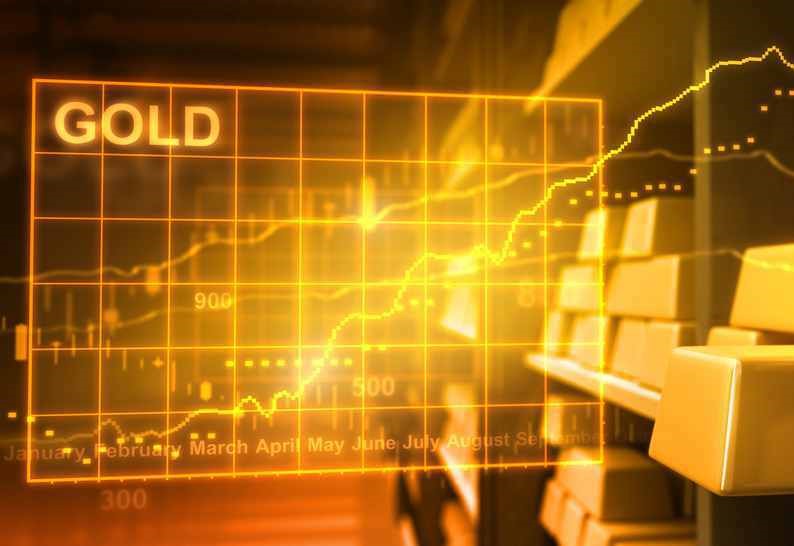How To Invest In Gold - 7 Best Ways To Invest In Gold In Australia For Beginners
Investing in gold can be more value-preserving when the economy is unstable, what is the best way to invest in gold? If you're looking to make money off of gold, make sure you read on.
Gold has historically been valuable because it can be used as a hedge against currency devaluation, inflation, or deflation, and it is a sort of safe haven during some market crashes.
You may want to add gold to your portfolio, fortunately, investors can invest in gold in many ways, not only the common physical gold coins, but also gold ETF, gold futures, and other gold derivatives that track the gold price movements.
This article is going to talk about how to invest in gold effectively as a beginner.
Why is Gold Investment Popular?
The biggest demand for gold is the production of jewelry, followed by direct investment in gold, including coins, bullion (a bar or coin stamped with its value and purity), medals, and standard gold bars.
Gold is always viewed as“safe haven” that some people consider to be valuable during periods of uncertainty, insecurity, economic or political turmoil, wars, devaluation, etc., This is a key reason why the price of gold tends to go up in 2022.
Gold is also valuable as an industrial metal because it is a good conductor of electricity, and is also used to make dentistry items and technological gadgets.
✅ Gold has always been a valuable commodity
✅ Gold is a global currency
✅ Gold is an excellent tool to hedge against inflation.
✅ Gold is a valuable addition to a diversified portfolio.
Therefore, whenever the world economy is unstable and the global situation is turbulent, gold has become the object of pursuit.
What Determines the Price of Gold?
The supply and demand of gold
Like any other commodity, gold trades based on supply and demand, and that interplay ultimately determines what the spot price of gold is at any given point. Economic downturns usually see the price of gold rising as demand from investors increases.
The supply of gold in the world is quite large but is often hard to extract. According to the World Gold Council, there are about 190,000 metric tons of gold being used above the ground with 54,000 metric tons located below the ground that can be mined using modern technology.
The value of the US dollar
The price of gold is usually inversely proportional to the value of the dollar since gold is denominated in dollars. A stronger dollar tends to make the price of gold lower, while a weaker dollar may drive the gold price higher by increasing demand.
Investment Demand
Gold has been viewed as a safe-haven investment and a store of value, so gold and silver offer ample trading opportunities and high liquidity.
Read more: What Drives The Gold Price In Australian Dollar (AUD)?
How To Make Money From Gold Investment?
First of all, there is a very important thing that you must know before investing in gold, that is, no matter which way you use to invest in gold, it will not generate dividends as stock! Gold itself is not a company, and there is no way to generate profits, so there will be no "dividends", no one wants to borrow gold for use, and everyone buys gold to save or buy low and sell high.
Therefore, no matter which method you invest in gold, the only way to make a profit on gold is to "buy low and sell high to make a difference", which must be noticed.
Well, what are the ways for investing in gold? Let's start with the longest time according to the timeline!
How To Invest in Gold for Beginners?
1. Buy Gold Jewelry, Gold Bullion, bars, and coins
Investing in Physical Gold is the most direct way of gold investment. Its market value is tied to the value of its pure gold. When you buy physical gold, you must pay the full price, while the costs involve storage, markups, and related transaction fees.
Physical gold is easy to buy, but it has very high markups which often make it a poor option for gold investment. Pure gold is 24 karat (how purity is measured), however, a lot of jewelry can be much lower in terms of purity.
2. Invest In Gold certificates
Gold certificates are notes issued by a company that owns gold, giving a direct investor exposure without owning the physical asset. The main issue with this form of gold investment is the trust factor. The certificates are as worthy as the company backing them. This is why The Perth Mint, backed by the government of Western Australia, is one of the most desirable options for gold certificates in the world.
3. Invest In Gold Based Exchange Traded Funds (ETFs)
Investors that don't care about holding physical gold but wish to have direct exposure can opt for an exchange-traded fund (ETF) like SPDR Gold Shares, it is the first gold ETF specifically to track the price of gold launched in 2004.
There are other sorts of funds, like Mining-focused ETFs, and Vectors Junior Gold Miners ETFs. In addition to gold, some ETFs also have exposure to other metals.
You can research the various costs and fees of each ETF to determine what is affordable and appropriate for your portfolio.
4. Trade Gold Futures
Gold future refers to the future contract that takes the gold price at a certain point in the future as the trading target, and will not actually trade the gold itself.
The profit and loss of investing in gold futures depend on the gap between the gold price at the time of entering and exiting the market. If the position is not closed halfway, we have to continue to renew the futures contract after expiration.
5. Trade Gold Contracts For Difference (CFDs)
A CFD contract for gold is an agreement between a buyer and a seller to exchange a specified amount of gold at a date in the future. The value of the contract fluctuates as the price moves up and down, with the accounts of both the seller and buyer being adjusted accordingly. Gold CFDs are a kind of derivative, traders track the gold price movements and use leverage (i.e. credit) to magnify the profits and losses.
In this CFDs resemble futures but with some differences:
A CFD has no expiry date – it's possible to allow the position to run as long as desired
CFDs can be very much smaller than futures or options – one single unit is possible in a CFD
The universe of CFDs can encompass any underlying which has a changeable price – even cryptocurrencies
CFDs are not traded through an exchange but over the counter (OTC) with a CFD broker
Gold CFDs will suit traders who wish to speculate on the price of gold without owning any of the underlying assets. CFDs also allow substantial leverage. This allows the risk-tolerant to make short-term trades in a straightforward manner on the future direction of gold prices.
6. Buy Gold mining stocks
Mining stocks are a way to invest in the gold industry, rather than the physical asset itself. Gains can be made in several ways: first in the increased value of gold (because the stock values go up accordingly), and also from increased production and business expansion. There are still risks to owning gold mining stocks. Sometimes the company underperforms, the workers go on strike, and disasters like a mine collapse or gas leak can occur. These factors can cost lives and halt production, driving prices down in the aftermath.
7. Streaming and royalty companies
Streaming and royalty companies provide miners with cash upfront in exchange for the right to buy gold for future reduced rates, allowing them to get paid in gold without going through the expense of running a mine.
What's the Best Way for a Beginner to Invest in Gold?
Each option has its own trade-offs. Like any other investment, there's no standard option for investing in gold, however, research into how gold price works and learning about the pros/cons of each type of gold investment will help you make the right decision.
Is It Still Worth Investing in Gold for 2023?
Gold is the most actively traded commodity in the world which means there's certainly the liquidity to make trading easy. The price is also volatile – it changes often and a lot – and trading is about being on the right side of price changes. So, yes, there certainly is a possibility of usefully trading in gold.
Many experts consider gold to be a volatile investment and advise keeping holdings at less than 10% of an overall investment portfolio.
Many experts also advise buying small amounts of gold over a long period of time. Often the price of gold and gold-related stocks is correlated, meaning that the two rise and fall together. Since the results are best suited to long-term investment, most advisors recommend buying it over time to average the cost.
Trade XAUUSD-Gold online with Mitrade!
Gold ( XAUUSD) price chart on mitrade▼
10 Tips for Investing in Gold Wisely
There are many expert opinions throughout the gold investment world. Here are our top 10 tips to help you make the best decision.
1. Purchase some physical gold and silver
Gold functioned as money for 5000 years, and it was only in 1971 when the gold standard stopped being used. Having said that, experts recommend that you have some as insurance against the crash of the monetary system.
2. Don’t invest solely in indirect ownership over the long term
Certain paper products do not guarantee that you actually own the gold and often include cash settlement clauses that will pay you out in cash instead of physical metals. In a harsh monetary crisis or war, this may cause an investment loss.
3. Ensure it is under your direct and unencumbered ownership
If you buy physical gold, experts recommend that you store it close to where you live in a jurisdiction that has strong private property rights so it cannot be pledged, hedged, or leased out.
4. Purchase only the most liquid coins and bars
Experts recommend that you invest in coins as much as possible because they are easier to use than an entire gold bar. Ensure that the coins are legal tender with a low fabrication fee.
5. Build up stocks over time
Gold is a traditional store of value as well as monetary insurance that will help you build up savings over time. In hard times of war and famine when currencies lost their value, gold and silver were used to purchase homes and provide food for weeks.
6. Avoid using credit and buy gold with savings
Experts recommend saving before investing so that any gold bought with savings is fully yours. This should apply to all types of investments.
7. Only invest money you don't need for five years
According to some analysts, gold returns are best realized over long time frames, so investing all your money in gold right now may mean missed short-term investment opportunities.
Since markets are volatile, they advise that you use gold investment as a security for the long term, and have some capital on hand to invest in current opportunities.
8. Set short and long-term objectives
Experts recommend that you set objectives and review them often, avoiding any quick decisions that might compromise your overall strategy.
9. Invest only what you can afford
Most investment advisors recommend the use of dollar-cost averaging to buy small amounts over time in order to spread the purchase cost and build a sizeable position.
10. Allocate Gold to 10-15% of Your Investment Portfolio
Analysts recommend investing no more than 10-15% of your investment portfolio in precious metals, including gold. The best portfolios, according to many experts, are diverse portfolios that are protected from any sharp fluctuations in the value of any one asset type.
A Final Word
There are 7 popular ways to invest in gold, such as buying the actual metal, purchasing gold funds, and buying gold options.
Many beginners prefer investing in physical assets like gold coins, bars, or bullion. Experienced investors prefer a more liquid and low-cost way to invest, like mutual funds and exchange-traded funds that invest in the shares of mining companies.
Advanced investors may trade gold futures or options. This is a risky investment and not suited for beginners.
Whatever form of gold investment you choose, you can rest assured that gold investment has been around for thousands of years and is unlikely to disappear anytime soon.
So do your research, invest responsibly, and invest wisely!
Start your first trade
Finding opportunities in their rising value OR their drop with trading Gold derivatives - contracts that track their change in value (CFDs)! At Mitrade, you can invest as little as $100 in gold derivatives( CFD). And since you're not actually owning the physical gold, you can invest in their rising value OR their drop.
 Forex 丨 Gold 丨 Shares 丨Commidities丨MoreStrictly regulated0 commission, low spreadsDaily Forex Signals with analysisNegative Balance Protection
Forex 丨 Gold 丨 Shares 丨Commidities丨MoreStrictly regulated0 commission, low spreadsDaily Forex Signals with analysisNegative Balance Protection
* The content presented above, whether from a third party or not, is considered as general advice only. This article should not be construed as containing investment advice, investment recommendations, an offer of or solicitation for any transactions in financial instruments.
- Original
- Trading Analysis


Risk Warning: Trading may result in the loss of your entire capital. Trading OTC derivatives may not be suitable for everyone. Please consider our legal disclosure documents before using our services and ensure that you understand the risks involved. You do not own or have any interest in the underlying assets.




